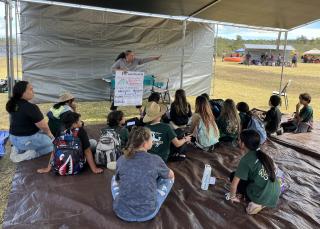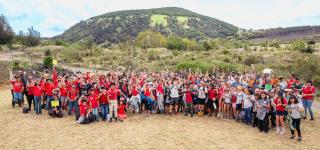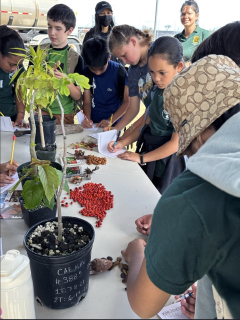Hawaiʻi Island’s Biocultural Blitz: Conservation through education
HAWAIʻI — March 2024 marked the seventh annual Puʻuwaʻawaʻa Biocultural Blitz on Hawaiʻi Island, an event where local conservation groups set up activity stations with games, hula dancing, chanting, with plant, wood and rock samples to engage young children. The event included 250 fourth graders, from seven schools, eleven conservation groups, sixty-three volunteers and three government agencies to support the immersive day of learning this year.
It’s called a blitz because the fourth graders are given 10 minutes at each station to absorb as much knowledge as possible before jetting off to the next one. As you can imagine, 250 fourth graders having to scramble around every 10 minutes to the right location was quite the whirlwind!
The different stations taught the students about the ecosystems within their ahupuaʻa. An ahupuaʻa or ridge to reef resource management concept is a traditional Hawaiian form of land management and food production system based on access to resources, which is still in practice today. This system allowed the remote island nation to be entirely self-sufficient for centuries before European contact.
The location of the blitz is one of the last remaining lowland dry forests in Hawaiʻi known as Puʻuwaʻawaʻa. The 37,000-acre forest reserve is an ideal site for a biocultural field trip because of the strong stewardship restoration efforts and its cultural significance. In the 1800s, much of the native vegetation was cleared for ranching and invasive. As a result, fire prone grasses grew to dominate the landscape. Native species now compete with fast-growing non-natives and suffer damage from introduced animals. These days restoration is the name of the game and was just one of the many lessons taught to the students.

Puʻuwaʻawaʻa is one of two Forest Service units of the Hawaiʻi Experimental Tropical Forest where research contributes to how sensitive ecosystems are protected and managed. Much of the resource management outside the experimental forest is community-based and led by the lineal descendants of the area who have managed to keep the large ahupuaʻa intact despite environmental challenges. Four generations of Puʻuwaʻawaʻa descendants participated in the event and shared their knowledge of the site’s genealogy and rich history with the students. Identifying native and non-native species and mālama ʻāina (connecting to and caring for the land) were other key learning outcomes. These are fundamental lessons to pass on to the next generation because they carry knowledge and connection rooted in preserving an ecosystem instead of rebuilding it after it has been lost.
Pilina ʻĀina is a youth conservation education partnership program between the Forest Service, the University of Hawaiʻi at Mānoa and the Akaka Foundation for Tropical Forests who collectively work to promote cultural resilience and provide access to place-based, biocultural stewardship learning opportunities for underserved students and teachers on Hawaiʻi Island. The program is a collaborative effort with Hawaiʻi’s Department of Forestry and Wildlife Nāpuʻu Conservation Project to bring the event to life.

Pilina ʻĀina’s program coordinator, Leilā Dudley, delivered announcements almost entirely in Hawaiian, providing some translations throughout, which had a way of captivating and silencing the crowd while showcasing the revival of a language that was once banned from school instruction and almost lost. Two Hawaiian Immersion schools that attended are committed to perpetuating the language, culture, traditions, spirituality and character of the Hawaiian people by instructing students in the native ʻŌlelo Hawaiʻi.
Hawaiʻi has experienced extinction at unprecedented rates and been labelled the extinction capital of the world—a powerful message to convey to future generations to encourage them to protect the thousands of endemic species that cannot be found anywhere else. Unique events like the Biocultural Blitz are treasured because it does more than introduce kids to major environmental issues, it empowers them to be land stewards through hands-on experiences and personal connections.
Events like these have lasting impacts and provide myriad benefits to communities. They are supported and made possible through partnerships, Forest Service program resources and federal grant funding. Pilina ʻĀina was a lucky recipient of the National Inflation Reduction Act funds authorized by the Biden Administration to invest in the future of Americaʻs climate through urban and community forestry.
The day was filled with fun, laughter, and learning. The kids took home an incredible experience plus an Every Kid Outdoors pass which grants them and their family free access to hundreds of federal parks, lands, and waters for an entire year to continue their outdoor explorations and apply their knowledge.
“ʻAe hoihoi loa mākou e komo hou i kēia makahiki aʻe” meaning “We are very excited to participate again next year!” expressed Kaleo Perry from Ke Kula ʻo ʻEhunuikaimalino immersion school.


